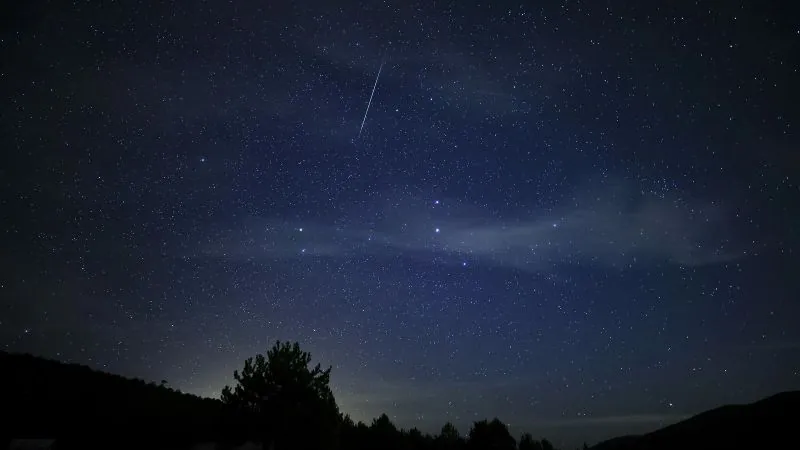
Don't Miss the Spectacular Quadrantid Meteor Shower: Your Ultimate Viewing Guide!
2025-01-02
Author: Ken Lee
As we usher in the new year, stargazers and astronomy enthusiasts are in for a treat! The Quadrantids meteor shower is set to peak soon, offering one of the most thrilling celestial displays of the year, according to NASA.
Why You Should Prepare for the Quadrantids
Unlike other meteor showers that last several days, the Quadrantids are notorious for their brief, intense peak—lasting around only six hours. This makes them one of the most fleeting meteor events in the night sky, so you'll want to be ready to catch the dazzling show!
Each year, Earth passes through the remnants of space debris from broken asteroids and comets, producing stunning meteor showers as these particles incinerate in our atmosphere. The Quadrantids originate from a narrow stream of debris, resulting in a quick burst of meteors as Earth intersects this dense trail at a perpendicular angle.
When and Where to Watch
The maximum activity is anticipated between 10 a.m. and 1 p.m. ET on January 3, 2025 (15:00-18:00 UTC), which favors viewers in Alaska, Hawaii, and far eastern Asia. However, the prime viewing opportunity occurs in the early hours before dawn.
East Coast of North America: Expect to see up to 25 meteors per hour.
West Coast: You could witness double this amount, thanks to a later sunrise!
Western Alaska: If weather conditions cooperate, you might catch over 100 meteors per hour.
Thanks to a waxing crescent moon that will set well before midnight, visibility of the shower should be exceptional!
Tips for Optimal Viewing
For the best experience, venture away from city lights. Here are some tips:
1. Choose a Dark Spot: Find a location free from light pollution.
2. Bring Comfortable Seating: Use a chair or blanket to lie back and gaze up.
3. Give Your Eyes Time to Adjust: Allow 20-30 minutes for your eyes to adapt to the darkness without distractions from devices.
4. Look in All Directions: While the radiant is located near the Big Dipper, meteors may appear anywhere in the sky.
The Fascinating Origins of the Quadrantids
The shower gets its name from the now-obsolete constellation Quadrans Muralis, which was first noted in 1795. As the constellation is no longer recognized by astronomers today, the shower's name reflects a celestial history that's often overlooked.
Interestingly, the Quadrantids are linked to both asteroid 2003 EH1—a "rock comet" measuring about 2 miles (3.2 km) across—and potentially Comet 96P/Machholz. The relationship between these objects points to a larger comet that broke apart thousands of years ago, leaving a legacy of meteoric activity including the Quadrantids, known for their bright fireballs.
Future Meteor Showers to Anticipate
Once the Quadrantids conclude, the next significant meteor shower won't occur until April. Here’s a sneak peek at upcoming showers in 2025:
Lyrids: April 21-22
Eta Aquariids: May 3-4
Southern Delta Aquariids: July 29-30
Perseids: August 12-13
Geminids: December 12-13
Don't let this astronomical marvel pass you by—get ready to witness the stunning Quadrantids! Prepare your gear, gather your friends, and head out to a dark site where the skies are clear. Happy meteor watching!




 Brasil (PT)
Brasil (PT)
 Canada (EN)
Canada (EN)
 Chile (ES)
Chile (ES)
 Česko (CS)
Česko (CS)
 대한민국 (KO)
대한민국 (KO)
 España (ES)
España (ES)
 France (FR)
France (FR)
 Hong Kong (EN)
Hong Kong (EN)
 Italia (IT)
Italia (IT)
 日本 (JA)
日本 (JA)
 Magyarország (HU)
Magyarország (HU)
 Norge (NO)
Norge (NO)
 Polska (PL)
Polska (PL)
 Schweiz (DE)
Schweiz (DE)
 Singapore (EN)
Singapore (EN)
 Sverige (SV)
Sverige (SV)
 Suomi (FI)
Suomi (FI)
 Türkiye (TR)
Türkiye (TR)
 الإمارات العربية المتحدة (AR)
الإمارات العربية المتحدة (AR)